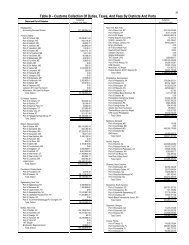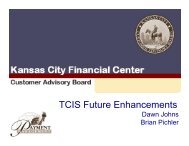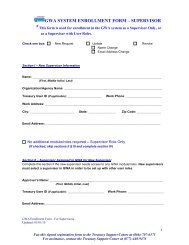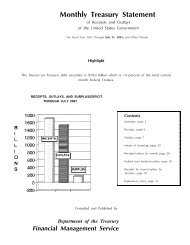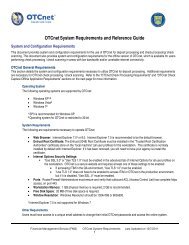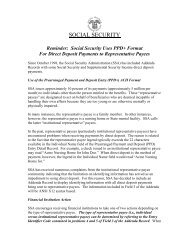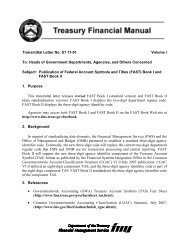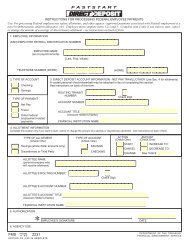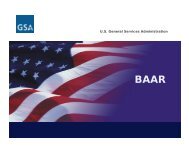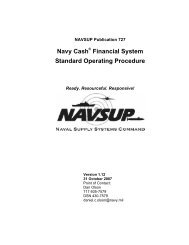EFTPS - Financial Management Service - Department of the Treasury
EFTPS - Financial Management Service - Department of the Treasury
EFTPS - Financial Management Service - Department of the Treasury
You also want an ePaper? Increase the reach of your titles
YUMPU automatically turns print PDFs into web optimized ePapers that Google loves.
<strong>EFTPS</strong>Electronic Federal Tax Payment SystemThe crucial role <strong>of</strong> awareness and familiarity in increasing usageResearch sponsored by <strong>the</strong> U.S. <strong>Treasury</strong>’s <strong>Financial</strong> <strong>Management</strong> <strong>Service</strong> and conducted by <strong>the</strong> Federal Reserve Bank <strong>of</strong> St. Louis
TABLE OF CONTENTSIntroduction ......................................................................1Qualitative Study ...............................................................3Quantitative Study .............................................................5Summary and Conclusions ................................................9OMB CONTROL NUMBER: 1545-1349
INTRODUCTIONBACKGROUNDThe Electronic Federal Tax Payment System(<strong>EFTPS</strong>) provides tax pr<strong>of</strong>essionals, small businessesand individuals a free electronic way to pay federaltaxes. The service is jointly <strong>of</strong>fered by two bureaus<strong>of</strong> <strong>the</strong> U.S. <strong>Department</strong> <strong>of</strong> <strong>the</strong> <strong>Treasury</strong>—<strong>the</strong> InternalRevenue <strong>Service</strong> (IRS) and <strong>the</strong> <strong>Financial</strong> <strong>Management</strong><strong>Service</strong> (FMS).increase usage by tax pr<strong>of</strong>essionals, small businessesand individuals. It also sought to understand whatmessages might persuade <strong>the</strong>se groups to use <strong>EFTPS</strong>.The Federal Reserve Bank <strong>of</strong> St. Louis, acting as fiscalagent <strong>of</strong> <strong>the</strong> U.S. <strong>Department</strong> <strong>of</strong> <strong>the</strong> <strong>Treasury</strong>, contractedwith Wirthlin Worldwide (now part <strong>of</strong> HarrisInteractive), a research-based consulting firm, to conductqualitative and quantitative research on increasing<strong>the</strong> usage <strong>of</strong> <strong>EFTPS</strong>.<strong>EFTPS</strong> <strong>of</strong>fers taxpayers <strong>the</strong> convenience and flexibilityto make federal tax payments over <strong>the</strong> Internet or bytelephone, ra<strong>the</strong>r than <strong>the</strong> traditional process <strong>of</strong> usingpaper coupons. Paying taxes electronically benefits taxpayers because it reduces <strong>the</strong> probability <strong>of</strong> errors andhelps <strong>the</strong>m avoid penalties.PROJECT SCOPE AND RESEARCH OBJECTIVESThe <strong>EFTPS</strong> research study was conducted in twophases: qualitative research, which concluded in late2003, and quantitative research,which was completed in 2004.Since <strong>EFTPS</strong> was introduced in 1996, more than5.5 million taxpayers have enrolled in <strong>the</strong> system and488 million payments totaling more than $11.6 trillionhave been collected. It is clear, however, that manymore individuals and small- to medium-sized businessescould also benefit from using <strong>the</strong> system. The IRS andFMS are committed to increasing <strong>EFTPS</strong> usage.To better understand <strong>the</strong> issues surrounding federaltax payment preferences, <strong>the</strong> IRS and FMS in2003 initiated a market research study <strong>of</strong> <strong>the</strong>barriers to enrolling in and using <strong>EFTPS</strong>.This study was designed to determine howwell <strong>EFTPS</strong> was known and how best to1
The specific objectives <strong>of</strong> <strong>the</strong> research were to:• understand <strong>the</strong> factors that currently facilitateor are barriers to <strong>EFTPS</strong> usage for individuals,small businesses and tax pr<strong>of</strong>essionals;• assess specific factors that may be leveraged toenhance <strong>EFTPS</strong> usage;• provide a foundation for a communicationsframework for <strong>EFTPS</strong> initiatives; and• assess <strong>the</strong> role <strong>of</strong> tax pr<strong>of</strong>essionals in influencingpeople’s use <strong>of</strong> <strong>EFTPS</strong>.Using a unique approach, <strong>the</strong> research sought toidentify <strong>the</strong> personal values that relate to <strong>EFTPS</strong> usageand how those values relate to payment preferencesamong <strong>the</strong> target audiences. This approach, calledvalues-based research, establishes linkages from <strong>the</strong>rational process <strong>of</strong> decision-making to <strong>the</strong> emotionalconsequences associated with those choices. Thevalues and o<strong>the</strong>r important elements are first identifiedin <strong>the</strong> qualitative study and <strong>the</strong>n measured in <strong>the</strong>quantitative study.<strong>EFTPS</strong> FACTS<strong>EFTPS</strong> FACTSTaxpayers who pay by check are about 30 times moreTaxpayers likely to have who tax pay penalties by check assessed are about against 30 times <strong>the</strong>m more thanlikely those to who have use tax electronic penalties forms assessed <strong>of</strong> payment. against <strong>the</strong>m.<strong>EFTPS</strong> uses <strong>the</strong> most advanced security measures availableto protect information.The <strong>EFTPS</strong> system allows users to schedule paymentsin advance, any time <strong>of</strong> day, any day <strong>of</strong> <strong>the</strong> week, fromany location.<strong>EFTPS</strong> issues an Acknowledgement Receipt Number<strong>EFTPS</strong> confi rming issues that an payment Acknowledgement instructions Receipt have been Number received.confirming In addition, an that <strong>EFTPS</strong>-OnLine payment instructions user can have access been and received. printIn up addition, to 16 months an <strong>EFTPS</strong>-OnLine <strong>of</strong> payment history. user can A taxpayer access and who printup makes to 16 a payment months <strong>of</strong> via payment phone using history. <strong>the</strong> A Voice taxpayer Response whomakes System a (VRS) payment will via receive phone an using Acknowledgement <strong>the</strong> Voice Response ReceiptSystem Number (VRS) and can will also receive check an payment Acknowledgement history.Receipt Number and can also check payment history.2
QUALITATIVE STUDYMETHODOLOGYThe qualitative research phase utilized AdvancedStrategy Labs (ASL), a proprietary research approachfrom Wirthlin Worldwide. The ASL methodology collectedindividual data in a group setting using separatecomputers and group discussion. This approach allowseach participant to respond to questions anonymouslyvia a computer—<strong>the</strong>reby preserving <strong>the</strong> integrityand confidentiality <strong>of</strong> responses—while also allowingfor group interaction and brainstorming. The interviewprocess uses a series <strong>of</strong> brainstorming questionsand laddering techniques designed to string toge<strong>the</strong>rresponses that help map a respondent’s thought process.The data that result show <strong>the</strong> linkages between <strong>the</strong>rational and emotional elements <strong>of</strong> decision-making.Individuals: 40 participants• Pay estimated taxes more frequently than once a year• Mix <strong>of</strong> occupations (service, manufacturing, wholesale/retailtrade, o<strong>the</strong>r)• Mix <strong>of</strong> demographics, including race and ethnicity• Target individuals over age <strong>of</strong> 40• File as individuals, jointly with spouse or as a soleproprietor, S corporation or partnershipA total <strong>of</strong> six ASL sessions were conducted in twocities—Houston and New York. Most sessions had 20participants and lasted approximately three hours.PARTICIPANT CRITERIATax pr<strong>of</strong>essionals: 40 participants• Owner <strong>of</strong> small tax firm or a senior tax accountant/account executive in a medium-sized firm• Mix <strong>of</strong> firm sizes (excluding <strong>the</strong> six largestaccounting/tax preparation firms)• Client base <strong>of</strong> individuals and small businessesSmall businesses: 56 participants• Annual tax liability <strong>of</strong> $2,500 to $200,000• Decision-maker on how taxes are paid for <strong>the</strong> business• Mix <strong>of</strong> industries (service, manufacturing, wholesale/retailtrade, o<strong>the</strong>r)• Mix <strong>of</strong> companies, by size <strong>of</strong> <strong>the</strong>ir revenue andnumber <strong>of</strong> employees• Mix included minority- and woman-ownedbusinessesKEY FINDINGSLack <strong>of</strong> awareness and familiarity with <strong>EFTPS</strong>is a significant barrier. Most individual and smallbusiness respondents were ei<strong>the</strong>r unaware <strong>of</strong> <strong>EFTPS</strong>or were confused about <strong>the</strong> service and its functionality.Their concerns resulted from a lack <strong>of</strong> knowledge3
and concern about <strong>the</strong> security <strong>of</strong> personal information.Tax pr<strong>of</strong>essionals were more aware <strong>of</strong> <strong>EFTPS</strong>, butsome lacked understanding <strong>of</strong> how to use <strong>the</strong> system.They expressed concerns about <strong>the</strong> enrollment processand <strong>the</strong>ir clients’ ability to pay taxes online.Tax pr<strong>of</strong>essionals are important catalysts toincreasing <strong>EFTPS</strong> usage. Nearly all <strong>of</strong> <strong>the</strong> tax pr<strong>of</strong>essionalsparticipating in <strong>the</strong> ASLs indicated that <strong>the</strong>ymake tax payment recommendations to <strong>the</strong>ir clients,and most individuals and small businesspersons indicatedthat <strong>the</strong>y use tax pr<strong>of</strong>essionals. Tax pr<strong>of</strong>essionalsconsider <strong>the</strong> relationships with <strong>the</strong>ir clients to bevery important. Those who believe <strong>EFTPS</strong> providesvaluable benefits to <strong>the</strong>ir clients are inclined to recommend<strong>the</strong> service.The impact <strong>of</strong> float on cash flow is an importantconsideration <strong>of</strong> those representing smallbusinesses. Many realize <strong>the</strong> float advantage towriting a check, and this period <strong>of</strong> float is part <strong>of</strong> <strong>the</strong>ircash flow management. Small-business respondentswere also concerned about payment verification,which <strong>the</strong>y felt was provided by a canceled check.Individuals are primarily concerned about verification<strong>of</strong> payment and security <strong>of</strong> personalinformation, and small businesses share this concern.Verification <strong>of</strong> payment includes confirmationthat <strong>the</strong> payment has been made and was debited from<strong>the</strong> bank account. In addition, some kind <strong>of</strong> pro<strong>of</strong> <strong>of</strong>payment was considered important in case <strong>of</strong> a disputewith <strong>the</strong> IRS. To date, <strong>the</strong> canceled check has satisfied<strong>the</strong>se concerns and provided a sense <strong>of</strong> control over<strong>the</strong> tax payment process. Some form <strong>of</strong> proxy for <strong>the</strong>check, such as a printable receipt, was likely to alleviatethis concern. Individuals are also concerned about <strong>the</strong>security <strong>of</strong> <strong>the</strong>ir personal communication and onlineinformation, as well as who at <strong>the</strong> IRS has access to<strong>the</strong>ir information.4
QUANTITATIVE STUDYMETHODOLOGYThe quantitative phase <strong>of</strong> <strong>the</strong> <strong>EFTPS</strong> research studywas a nationwide telephone survey <strong>of</strong> tax pr<strong>of</strong>essionals,individuals and those representing small businesses.The surveys were conducted in early 2004 with 1,500randomly selected people from key audience groups.The average interview length was 20 minutes.PARTICIPANT CRITERIATax pr<strong>of</strong>essionals: 500 participants• File at least 25 returns per year• CPAs, accountants, tax accountants, tax preparers• Mix <strong>of</strong> firm sizes (excluding <strong>the</strong> six largestaccounting/tax preparation firms)• Client base <strong>of</strong> individuals and small businessesSmall businesses: 600 participants• Annual tax liability <strong>of</strong> $2,500 to $200,000• Decision-maker on how taxes are paid for<strong>the</strong> business• File taxes under an Employer IdentificationNumber• Mix <strong>of</strong> industries• Mix included minority- and women-ownedbusinesses• 25 percent were already enrolled in <strong>EFTPS</strong>Individuals: 400 participants• Must make at least two estimated tax paymentsper year• Primary or joint decision-maker on how taxes arepaid for <strong>the</strong> household• Includes individual taxpayers and those who file asa sole proprietor, S corporation or partnership• Mix <strong>of</strong> ages, occupations and demographicsThe error due to sampling at <strong>the</strong> 95 percent confidencelevel is +/- 4.9 percentage points for <strong>the</strong> individualsgroup, +/- 4.4 percentage points for <strong>the</strong> taxpr<strong>of</strong>essional group and +/- 4.0 percentage points for<strong>the</strong> small business group.RESEARCH OBJECTIVESBuilding on <strong>the</strong> results <strong>of</strong> <strong>the</strong> ASL sessions, this studywas designed to:• quantify <strong>the</strong> levels <strong>of</strong> awareness and familiarity;• measure reactions to proposed initiatives to increase<strong>EFTPS</strong> usage;• measure <strong>the</strong> prevalence <strong>of</strong> barriers identified;• more fully understand <strong>the</strong> role <strong>of</strong> taxpr<strong>of</strong>essionals and o<strong>the</strong>r influencers <strong>of</strong> <strong>the</strong> taxpayment method;• explore <strong>the</strong> role and perception <strong>of</strong> <strong>the</strong> IRS; and• assess <strong>the</strong> overall favorability <strong>of</strong> <strong>EFTPS</strong> across <strong>the</strong>target audience.KEY FINDINGSFamiliarity with, and Favorability toward, <strong>EFTPS</strong>Unprompted awareness is low among all groups.The survey revealed a need to build awareness and5
familiarity <strong>of</strong> <strong>EFTPS</strong> among all groups <strong>of</strong> <strong>the</strong> targetaudience. Only 30 percent <strong>of</strong> tax pr<strong>of</strong>essionals, 10percent <strong>of</strong> small businesses and 5 percent <strong>of</strong> individualssurveyed mentioned <strong>EFTPS</strong> by name. When askedabout options for paying electronically, many o<strong>the</strong>rsmentioned more general electronic means <strong>of</strong> payment,such as credit cards, electronic filing <strong>of</strong> tax forms and<strong>the</strong> Internet. Nearly half (46 percent) <strong>of</strong> <strong>the</strong> individualssurveyed reported no knowledge <strong>of</strong> any electronic means fortax payment.Tax pr<strong>of</strong>essionals are <strong>the</strong> most familiar with<strong>EFTPS</strong>; however, familiarity is lacking amongsmall businesses and individuals. More thanhalf (51 percent) <strong>of</strong> tax pr<strong>of</strong>essionals report that <strong>the</strong>yare somewhat familiar with <strong>EFTPS</strong>, and a smallerpercentage (29 percent) are very familiar. Amongsmall businesses, 43 percent are familiar with <strong>EFTPS</strong>.Among individuals, few (12 percent) have any familiarity,and nearly half (44 percent) have never heard<strong>of</strong> <strong>EFTPS</strong>.Overall, reactions to <strong>EFTPS</strong> are generallypositive for tax pr<strong>of</strong>essionals and small businesses.Nearly half <strong>of</strong> tax pr<strong>of</strong>essionals and smallbusinesses are highly favorable toward <strong>EFTPS</strong>;however, individuals are significantly more cautiousabout <strong>EFTPS</strong>. Familiarity with <strong>EFTPS</strong> is tiedto favorability. Among all audiences, those alreadyvery familiar with <strong>EFTPS</strong> are significantly more likelyto be highly favorable than those who are unfamiliar.The Role <strong>of</strong> Tax Pr<strong>of</strong>essionalsTax pr<strong>of</strong>essionals have a great deal <strong>of</strong> influencein <strong>the</strong> tax payment process. Tax pr<strong>of</strong>essionals areprotective and concerned about <strong>the</strong>ir client relationshipsand are more likely to recommend electronicmethods <strong>of</strong> payment if <strong>the</strong>ir clients convey interest.Nearly all tax pr<strong>of</strong>essionals make recommendationsto <strong>the</strong>ir clients and believe <strong>the</strong>ir clients accept <strong>the</strong>m.Most clients agree with this assessment: More thanthree-quarters <strong>of</strong> small businesses and individuals say<strong>the</strong>y are very likely to accept <strong>the</strong>ir tax pr<strong>of</strong>essionals’recommendations.The vast majority (92 percent <strong>of</strong> small businessesand 85 percent <strong>of</strong> individuals) use taxpr<strong>of</strong>essionals. Among those who use tax pr<strong>of</strong>essionals,<strong>the</strong> majority report that <strong>the</strong> decision on how taxpayments are made is a joint effort between <strong>the</strong>mselvesand <strong>the</strong>ir tax pr<strong>of</strong>essionals. Nearly one-third <strong>of</strong> taxpr<strong>of</strong>essionals have made tax payments on behalf <strong>of</strong><strong>the</strong>ir clients using <strong>EFTPS</strong>. 6
The Role <strong>of</strong> Tax Pr<strong>of</strong>essionals in Making RecommendationsHow <strong>of</strong>ten do you make recommendationsabout how to pay federal taxes?How <strong>of</strong>ten do clients accept yourrecommendations?Very Often47 6228 Somewhat Often3220 Rarely44 Never0PercentPercentPercentages may not equal 100 percent because <strong>of</strong> rounding • Base: Tax Pr<strong>of</strong>essionals (n=500), Tax Pr<strong>of</strong>essionals Who Recommend (n=476)Perceptions <strong>of</strong> Check Paymentsvs. Electronic PaymentsThe quantitative research measured <strong>the</strong> importance<strong>of</strong> certain attributes to respondents when makingdecisions about tax payments. The results very clearlyindicate that security <strong>of</strong> payment information, avoidinglate payment penalties, receiving verifi cation <strong>of</strong> paymentandhaving a fast and easy process are critically important.Tax pr<strong>of</strong>essionals are more likely to associate <strong>the</strong>seimportant attributes with electronic payment. However,my clients are comfortable with <strong>the</strong> process is verystrongly linked with payment by check. The chartbelow shows that protecting <strong>the</strong> client relationshipsupersedes recommending electronic payment.Small businesses and individuals still attribute <strong>the</strong>important variable <strong>of</strong> security to checks. IndividualsImportance <strong>of</strong> Attributes When Making Decisions about Tax Payments(Mean importance using 1-10 scale, with 10 being most important)AttributeTaxPr<strong>of</strong>essionalsn=500SmallBusinessesn=600Individualsn=400Payment and client/personal company info is secure 8.6 8.8 8.7Likelihood to Take Recommendation from TaxPr<strong>of</strong>essionals Avoiding late payment on penalties How to Pay Federal Taxes8.5 8.6 7.8Receive pro<strong>of</strong> <strong>of</strong> payment 8.4 8.0 7.7Individuals20Payment n=339process is fast and easy767.9 8.196%7.1Small Businessesn=549178198%7
are also more likely to equate verification <strong>of</strong> paymentwith checks ra<strong>the</strong>r than electronic payments.Perceptions <strong>of</strong> Transition to Electronic PaymentThe enrollment process does not appear to be abarrier among tax pr<strong>of</strong>essionals or small businesses.Tax pr<strong>of</strong>essionals and small businesses overwhelminglyreport that <strong>the</strong> <strong>EFTPS</strong> enrollment processis straightforward and easy—not difficult and confusing.Individuals, on <strong>the</strong> o<strong>the</strong>r hand, are likely to find<strong>the</strong> enrollment process daunting—41 percent find <strong>the</strong>process difficult and confusing.Nearly every small business surveyed (98 percent)owns a computer and has access to <strong>the</strong>Internet. This reflects familiarity with computersand s<strong>of</strong>tware applications among <strong>the</strong> target audience,which indicates that making <strong>the</strong> transition to <strong>EFTPS</strong>would not be expensive or difficult for taxpayers.Concerns about float identified in <strong>the</strong> qualitative studywere not replicated in <strong>the</strong> quantitative study.How Respondents Attach Attributes to Form <strong>of</strong> PaymentAttributeTaxPr<strong>of</strong>essionalsn=500SmallBusinessesn=600Individualsn=400Payment and client/personal company info is secure Electronic CheckCheckAvoiding late payment penalties Electronic Electronic Nei<strong>the</strong>rReceive pro<strong>of</strong> <strong>of</strong> payment Electronic Electronic CheckPayment process is fast and easy Electronic Electronic Nei<strong>the</strong>r8
SUMMARY ANDCONCLUSIONSClearly, <strong>EFTPS</strong> is early in <strong>the</strong> adoption curve for smallbusinesses and individuals. Building awareness andfamiliarity through educational efforts will be effectivein boosting <strong>the</strong> use <strong>of</strong> <strong>EFTPS</strong>. Specifically, increasing<strong>the</strong> knowledge <strong>of</strong>, and comfort level with, <strong>the</strong> security<strong>of</strong> both <strong>the</strong> <strong>EFTPS</strong> system and taxpayers’ personalinformation will likely overcome concerns stemmingfrom a lack <strong>of</strong> understanding.tremendous with an aggressive communicationsprogram. And <strong>the</strong> pay<strong>of</strong>f is clear. As usage <strong>of</strong> thiselectronic payment method increases, <strong>the</strong> number<strong>of</strong> paper payments processed will decrease, resultingin significant cost savings for <strong>the</strong> government. Taxpr<strong>of</strong>essionals, small businesses and individuals willbenefit from greater accuracy, timeliness and efficiency<strong>of</strong> tax payments.Also important to consider is <strong>the</strong> critical role <strong>of</strong> taxpr<strong>of</strong>essionals. Tax pr<strong>of</strong>essionals realize a sense <strong>of</strong>accomplishment when <strong>the</strong>ir clients view <strong>the</strong>m as helpfuland perform <strong>the</strong>ir responsibilities well. Tax pr<strong>of</strong>essionalsreport making recommendations on paymentissues to <strong>the</strong>ir clients, and <strong>the</strong> clients in turn reportthat <strong>the</strong>y usually agree with <strong>the</strong> recommendations.Thus, encouraging tax pr<strong>of</strong>essionals to educate <strong>the</strong>irclients on <strong>the</strong> benefits <strong>of</strong> electronic payment wouldlikely lead to greater use <strong>of</strong> <strong>EFTPS</strong>. At <strong>the</strong> same time,communicating directly with small businesses andindividuals will be important to gain trust and helpmotivate tax pr<strong>of</strong>essionals to encourage <strong>the</strong>ir clients touse <strong>EFTPS</strong>.Acceptance <strong>of</strong> <strong>EFTPS</strong> could be facilitated if small businessesunderstand how <strong>the</strong> service will increase <strong>the</strong>irefficiency. Increased efficiency, as demonstrated in <strong>the</strong>values-based research, leads to a sense <strong>of</strong> control, securityand peace <strong>of</strong> mind concerning <strong>the</strong>ir businesses.Because familiarity is tied to favorability among allaudiences, <strong>the</strong> potential for growth in <strong>EFTPS</strong> usage is9



